fracTRON 1000 Falling Film Evaporator
Three-Stage fractional solvent distillation at 40 gallons/hour
fracTron uses three independent falling film evaporators that are designed for rapid ethanol removal. Using vertical tube heat transfer exchangers in combination with packed bed reactors, the system supports a continuous solvent recycling system capacity of 40 gallons per hour. This allows producers to drastically increase the efficiency of their solvent removal distillation process while improving distillate quality.
Important Articles For Falling Film Evaporation, Extraction Processes and Equipment
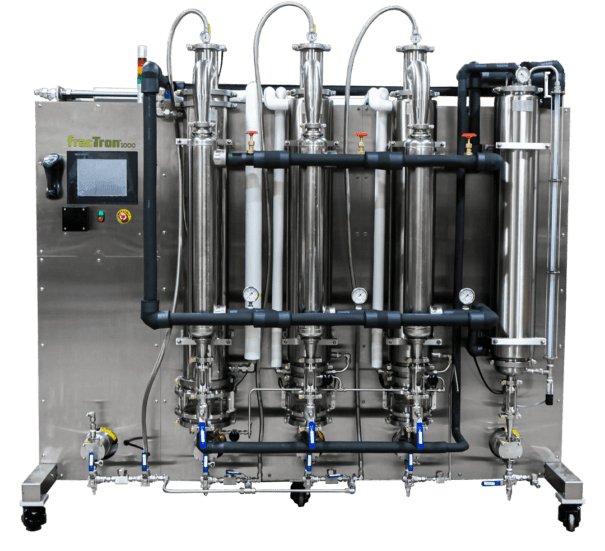
What is the fracTRON 1000 Falling Film Evaporator?
The fracTRON 1000 is a falling film evaporator, or thin film evaporator that functions as solvent recycling system. Also known as an FFE, the equipment features three liquid solvent evaporators. The evaporators feature vertical tube heat exchangers that have been optimized for ethanol removal. The system also incorporates packed bed reactor for high evaporation performance and integrated decarboxylation.
Each evaporator system is independently temperature controlled so it can be tuned to distill different liquid solvent. An inert carrier gas is incorporated to accelerate recovery while reducing flammability concerns. Programmable methods enable automated GMP process control with reporting, and GMP certified stainless-steel materials support global market requirements.
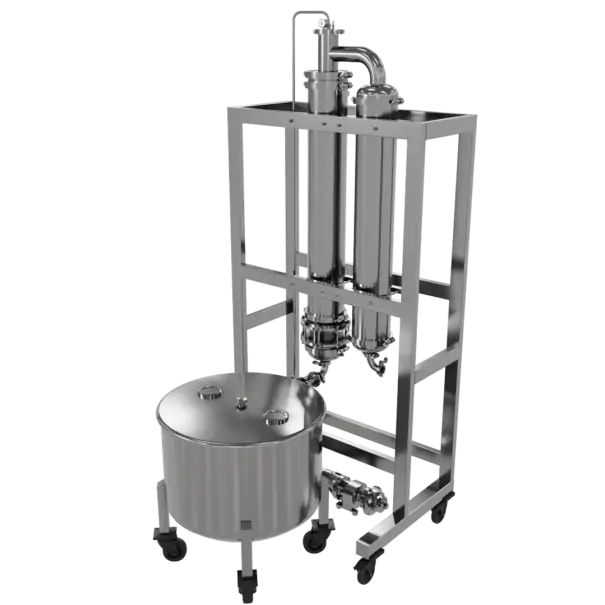
What is the fracTRON 100 Falling Film Evaporator?
The fracTron-100 is a small scale, cost efficient solution based on our fracTron technology. The fracTron-100 is a manual, single stage falling film distillation unit for rapid solvent removal with a recycling capacity of up to 60 gallons and a continuous process flow with an incorporated air pump. This is a fantastic solution for start-up extraction operations who need quality solvent removal processes at a reasonable price point.
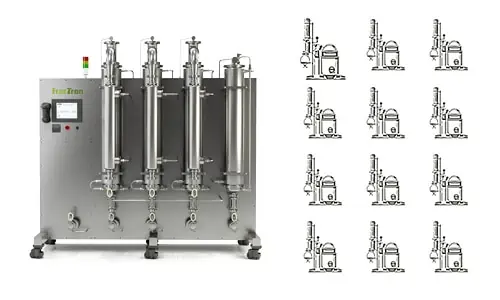
Read Publications
Could fracTRON replace Rotovaps?
Solvent Removal
Request the Solvent Removal Guide
Advantages of the fracTRON 1000 Three-Stage Solvent Distillation FFE
- 3-stage FFE allows superior evaporation performance and solvent removal. Optimized for ethanol.
- High performance vacuum system is distributed to each evaporator.
- Incorporates vertical tubular heat transfer exchangers and packed bed reactors for solvent recycling and optimal on-line oil finishing.
- Solvent removal eliminates secondary processing.
- Optional piping kit allows for distillate collection from any distillation stage.
- 40 gal/hr throughput capacity capable of replacing 5-12 lab scale rotovaps.
- Inert carrier gas accelerates throughput and reduces flammability concerns.
- Continuous process eliminates need for disassembly or re-running of batches. CIP methods reduces labor for cleaning.
- Programmable evaporation methods allow automated GMP process control.
Replace Your Rotovaps with fracTron Today
fracTron’s three-stage equipment features three separate falling film evaporators that allow fractional distillation. The equipment is capable of replacing up to 12- 50L rotary evaporators for superior recovery of solvent! Let us help you upgrade your distillation process.
How Do Evaporators Work?
Falling film evaporator systems utilize heated tubular evaporation chambers to separate liquid solvent based on their boiling points. An array of vertical tubes enable efficient heat transfer while preserving the integrity of the product oil. In hemp processing or extraction, this step is required to concentrate the oil and recover the liquid solvent.
The process starts by pumping ethanol into a distributor that introduces ethanol to the vertical tubes. “Falling film” refers to a thin film that is created as the ethanol or liquid solvent falls down the inside of the heated vertical metal tubing that is heated by circulating oil on the outside of the tubes. Optimal heat transfer on the walls of these tubes allows ethanol oil or other liquid solvent mixtures to evaporate at a high throughput rate before condensing on a chilled collector.
Vacuum systems are incorporated into the equipment to lower the boiling point of ethanol and improve mass transfer. The vacuum is maintained in each stage of the process with a single vacuum pump that is monitored by the system to maximize performance.
Unlike most falling film evaporators, the fracTron 1000 is able to independently pump liquid from stage to stage, control temperature, pressure and other variables in each of its three-stages making it optimal for total solvent evaporation without secondary processing.
What is a Thin Film Evaporator?
the fracTron could also be considered to be a “thin film evaporator.” As the name would imply, a thin film evaporator creates a “thin film” of a solvent/oil mixture to improve mass transfer and speed up the evaporation process. These systems often use vacuum pressure to reduce pressure, and the boiling point of the target solvent to decrease residence time on a heated surface to avoid product degradation. This kind of solvent distillation is very important for overall distillate product quality and production efficiency.
Falling Film Evaporator Specifications
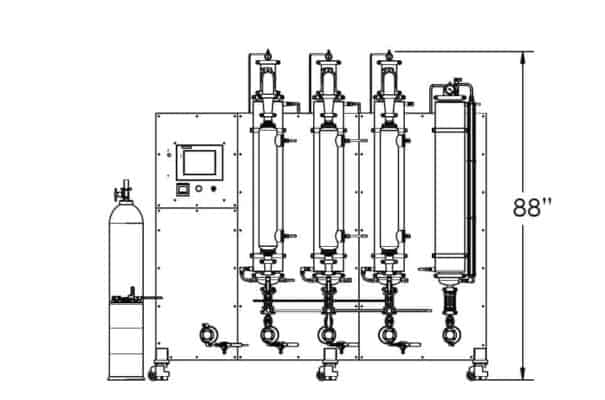
Total Process Control for GMP Compliance
Unlike standard lab rotary evaporator equipment used for solvent distillation, evaporation or recovery, the fracTron is built with total process control in mind. User authentication and programmable methods allow for a full-coverage of the fractional separation process. This includes tracking of throughput and yields, optional WiFi enabled monitoring and control, data visualization, and hardware control.
The integrated clean-in-place methods and pump allow automated cleaning between batches.
This level of process control gives fracTron 1000 the capability of lot, calibration and maintenance tracking, and barcode reporting – both electronically and through a paper trail. These capabilities are essential for advanced thin film evaporator technology to be compliant with current GMP requirements.
Learn More About Our Turnkey Manufacturing Solutions
Talk to our professionals for top solutions about where you are and where you want to go. Doing it on your own can be overwhelming, but just remember that you are not alone. We are here to help.
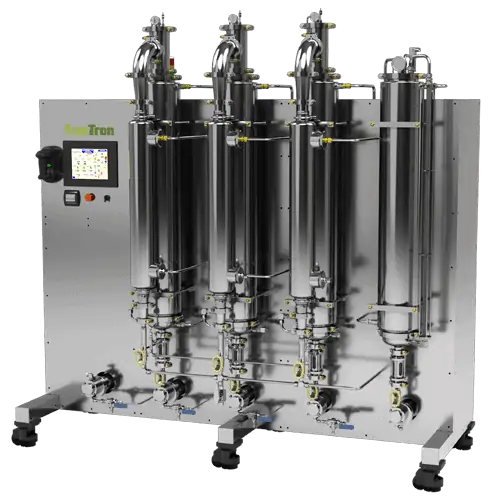
Essential Falling Film Evaporator Processing Training Available
If you are new to falling film or thin film evaporation equipment or falling film evaporators, we can provide all the necessary information you need to successfully implement this crucial method into your production. Contact our experts to learn more, or get a quote to upgrade your entire distillation process today with fracTron series.
What is the Advantage of the Triple Pass
Solvent Recovery
Removing the last percentages of ethanol compared to the first is far more difficult, especially in a single pass system with only one temperature setpoint. Changing the temperature of the heated media as the mixture becomes more concentrated with plant extract improves mass transfer and evaporation of the ethanol.
Learn More About fracTron Falling Film Evaporators
Download the product brochure to check detailed specifications and important information about the equipment.
Testimonials
Quality of equipment. Quality of customer service. Competency of experts in setting up new operations for prospective businesses.
Customer support has been great.
Great product from what seems like a solid company.
Fast professional friendly service.
Frequently Asked Questions
Can rotovaps be replaced with a falling film evaporators?
fracTron is our version of a falling film evaporator. The equipment is capable of replacing many rows of apps nearby streamlining the solvent removal process during ethanol extraction or winterization. The equipment is able to efficiently remove ethanol from the cbd oil to the point that it can be directly introduced into a wiped film evaporator.
One of the advantages to the FracTron is that it can be configured in several different ways to give it more versatility. It can be used as a 3-stage fractional distillation piece of equipment or it could be used also as a two-stage falling film evaporator and one stage decarboxylator unit for decarboxylation of oils.
Since the fraction is able to condition the oils in such a way that they can be introduced directly into a wiped film evaporator, the unit is capable of being fully integrated and automated to feed a wiped film distillation unit.
Can I feed my ethanol/extract mixture directly into the falling film?
Yes, the system is engineered to fit directly into any batch or continuous extraction process.
How does the fracTRON help reduce maintenance and automate cleaning?
The fracTRON is a continuous system, it doesn’t require disassembly between runs. When it needs to be cleaned, simply run the system with clean ethanol at 50C (in all columns). If inspection is required, remove the top two clamps to swab the surfaces.
How do you clean the fracTRON?
The system is cleaned by flushing with clean ethanol. The fracTRON has a piping manifold for even distribution of the liquid mixture which also helps to force cleaning solvent into potentially clogged tubes. The apparatus is easily disassembled for inspection.
Can I collect distillate from different stages independently?
With an optional piping package, yes. Having the ability to be set to 3 different setpoints throughout the system, select components can be evaporated and collected preferentially. This is particularly useful for industrial fractioning of terpenes.
Does the system come with methods?
Methods and formulas are delivered with the system.
Is degassing required after treatment with a falling film?
Depending on the operating conditions, degassing is still required after subjecting the extract/ethanol mixture to falling film evaporation. Degassing decreases the ethanol content of the mixture from ~10-15% from the evaporator to 2% which is required for wiped film evaporation. The time it takes to degass is largely dependent on the starting ethanol content as well.
What yield should we expect from the falling film evaporators?
Yield of plant extract is generally near 100%. Plant extracts have much higher boiling points than that of ethanol and the flow path of ethanol vapor is engineered so that if aggressive boiling of ethanol causes entrainment of plant extracts, the plant extracts are forced out of the vapor.
What is the surface area of the unit and how does that impact throughput?
Each stage contains 52 square feet of heated surface area for product evaporation. Generally, as surface area for product evaporation increases, the throughput of the system increases.
How does a falling film fit in my workflow?
Ethanol is the most common solvent for removal of fats and waxes from a plant extract and it needs to be removed from the mixture for downstream product refinement. Ratios of ethanol/winterized oil are typically between 4/1 and 10/1, high capacity falling film evaporators are necessary for large scale removal of ethanol from plant extracts.
Are solvent residuals still left in the oil after distillation?
Complete removal of solvent is hard to achieve with a single stage falling film evaporator because of the single temperature setpoint. As the liquid mixture flows through the tubes of the falling film evaporator, it changes composition due to vaporization of the volatile component. The change in composition changes the physical properties of the macroscopic mixture – including the boiling point. The fracTRON utilizes a triple pass falling film system to change the operating temperature of the evaporator as the temperature of the liquid mixture changes.
How clean is the ethanol coming from the falling film still?
Purity of product depends on many things such as temperature and flow rate of the heated media, flow rate of the liquid mixture to be distilled, pressure of the system, surface area of the heated surfaces, and mechanism of vapor-liquid separation. Depending on these conditions, most falling film evaporators remove 80-95% of ethanol from the starting mixture.
What does a falling film evaporators do?
Falling film evaporators are largely used to remove a solvent from a liquid mixture by evaporating the more volatile component. Compared to wiped film evaporators, falling film evaporators: have a higher heated surface area per footprint, are less equipped to distill highly viscous mixtures, and are much better equipped to distill a solvent at a high throughput. Falling film evaporators are vertical in orientation, and have a bundle of metal tubes in a metal container. The metal tubes are then heated with a flowing media and the heat is transferred to the liquid mixture to evaporate the volatile component as the mixture flows down the tubes. Single stage falling film evaporators have high surface area and can be set to a single temperature.
Certifications and Standards








Get in touch with our team to request a quote, learn more about our training or get help with your business plan.
We are dedicated to providing you with the best advice, quality and service in the industry.
Meet Our CEO and Founder Dr. Jon Thompson, Ph.D

Dr. Thompson is the founder and CEO of extraktLAB, where he has devoted his time to helping various hemp and botanical manufacturing companies in achieving their business goals. His expertise also extends to market development, strategic marketing, and business-to-business alliance formation across the globe.
His extensive knowledge of the botanical industry has earned him recognition in winning and implementing medical licenses in well-regulated, medically-modeled states.
More than that, Dr. Thompson is also a separations scientist with a strong background and deep industry experience in analytical instrumentation, in-vitro diagnostics, biotechnology, mining and homeland security markets.
